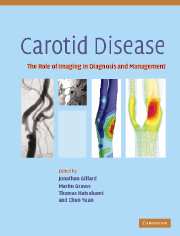Book contents
- Frontmatter
- Contents
- List of contributors
- List of abbreviations
- Introduction
- Background
- Luminal imaging techniques
- 9 Conventional carotid Doppler ultrasound
- 10 Conventional digital subtraction angiography for carotid disease
- 11 Magnetic resonance angiography of the carotid artery
- 12 Computed tomographic angiography of carotid artery stenosis
- 13 Cost-effectiveness analysis for carotid imaging
- Morphological plaque imaging
- Functional plaque imaging
- Plaque modelling
- Monitoring the local and distal effects of carotid interventions
- Monitoring pharmaceutical interventions
- Future directions in carotid plaque imaging
- Index
- References
10 - Conventional digital subtraction angiography for carotid disease
from Luminal imaging techniques
Published online by Cambridge University Press: 03 December 2009
- Frontmatter
- Contents
- List of contributors
- List of abbreviations
- Introduction
- Background
- Luminal imaging techniques
- 9 Conventional carotid Doppler ultrasound
- 10 Conventional digital subtraction angiography for carotid disease
- 11 Magnetic resonance angiography of the carotid artery
- 12 Computed tomographic angiography of carotid artery stenosis
- 13 Cost-effectiveness analysis for carotid imaging
- Morphological plaque imaging
- Functional plaque imaging
- Plaque modelling
- Monitoring the local and distal effects of carotid interventions
- Monitoring pharmaceutical interventions
- Future directions in carotid plaque imaging
- Index
- References
Summary
Introduction
Carotid endarterectomy is now one of the most commonly performed vascular operations in the Western world, with significant increases in rates since the publication of large randomized trials such as the North American symptomatic carotid endarterectomy trial (NASCET) and the European carotid surgery trial [ECST], which have clearly demonstrated the benefits of surgery over medical therapy in recently symptomatic patients with severe carotid stenosis (randomized trial of endarterectomy for recently symptomatic carotid stenosis: final results of the MRC European carotid surgery trial (ECST), 1998; Barnett et al., 1998; Tu et al., 1998). In these trials, risk stratification was mainly based on severity of luminal stenosis and this has naturally highlighted the importance of accurate carotid imaging for patient selection. The gold standard method, in terms of diagnostic accuracy, for the measurement of stenosis remains conventional digital subtraction angiography (DSA), which was in routine use at the time of these trials. There are, however, several disadvantages associated with DSA. It is a relatively expensive and labor-intensive procedure whose costs may be up to 2.4 times that of alternative procedures such as magnetic resonance angiography (MRA) (U-King-Im et al., 2004a). Moreover, patients, if given the choice, may tend to prefer less invasive modalities such as MRA (U. King-Im et al., 2004c).
Keywords
- Type
- Chapter
- Information
- Carotid DiseaseThe Role of Imaging in Diagnosis and Management, pp. 126 - 139Publisher: Cambridge University PressPrint publication year: 2006
References
- 1
- Cited by



